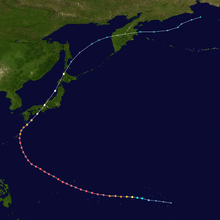Typhoon Nancy (1961)
| Category 5 (Saffir–Simpson scale) | |
|
A radar image of Nancy | |
| Formed | September 7, 1961 |
|---|---|
| Dissipated | September 22, 1961 |
| (Extratropical after September 16) | |
| Highest winds |
1-minute sustained: 345 km/h (215 mph) |
| Lowest pressure | 882 hPa (mbar); 26.05 inHg |
| Fatalities | 172–191 direct |
| Damage | $500 million (1961 USD) |
| Areas affected | Guam, Ryūkyū Islands, Japan |
| Part of the 1961 Pacific typhoon season | |
Super Typhoon Nancy, also known as the 2nd Muroto Typhoon (第二室戸台風 Daini-muroto Taifū), was an extremely powerful tropical cyclone of the 1961 Pacific typhoon season. The system had possibly the strongest winds ever measured in a tropical cyclone, tied with Hurricane Patricia of 2015. It caused extensive damage and at least 173 deaths and thousands of injuries in Japan and elsewhere in September 1961.
Meteorological history

A tropical depression formed from a low near Kwajalein Atoll on September 7. It strengthened rapidly; by the time position fixes could be taken, Nancy was nearly a super typhoon. Moving gradually westward, Nancy explosively deepened and reached wind speeds equivalent to a Category 5 (Saffir–Simpson Hurricane Scale) on September 9.[1] It would maintain that intensity for the next several days.
Shortly after reaching peak intensity, Nancy approached the Ryūkyū Islands and began turning. It passed near Okinawa and over Haze. The ridge steering Nancy broke down, and the typhoon turned sharply and headed towards Japan. Nancy made landfall as a strong typhoon on September 16 as it passed directly over Muroto Zaki. Nancy made a second landfall on Honshū near Osaka. The typhoon rapidly traveled up the length of the island as it continued accelerating, eventually reaching a forward speed of 65 mph (100 km/h, 55 knots).[2] The typhoon quickly crossed over Hokkaidō before entering the Sea of Okhotsk as a tropical storm. Nancy went extratropical on September 17. The extratropical system eventually crossed over Kamchatka and entered the open ocean.[3]
Impact
Although no monetary value of all damage is known, damage was "phenomenal"[2] in all areas where Nancy hit. There were at least 173 deaths and 19 people unaccounted for.
Guam
On Guam, over half of all crops were destroyed by heavy winds and rain. A total of $40,000 (1961 USD) worth of damage was done to roads on the island. Most of the damage was on the southern end of the island. No deaths were reported on Guam.[2]
Japan
In Japan, 172 people were killed, 18 were missing, and 3,184 people were injured. These totals made Nancy the sixth-deadliest typhoon to hit Japan at the time. Timely warnings and adequate preparations were probably responsible for the relatively low death toll. The damage was "small" relative to other typhoons that impacted densely populated areas of Japan.[2]
Hundreds of thousands of people had their lives disrupted. Super typhoon Nancy destroyed 11,539 houses, damaged 32,604 homes, and flooded 280,078 others. Although the exact number may never be known, the Stars and Stripes reported in late September that over 1,056 ships and fishing vessels were sunk or blown ashore and many more were damaged.[2]
Floodwaters washed away 566 bridges and caused 1146 landslides. Roads were destroyed at a total of 2,053 locations.[2] Damages in Osaka amounted to $500 million (1961 USD).[4]
On Okinawa, low-lying areas experienced heavy flooding, which did significant damage to agriculture and structures.[2] On Amami-o-Shima, one person was missing and another was badly injured. A ship was sunk. Extensive flooding of crops and houses left 152 people homeless.[2]
Due to Nancy's damage and death toll, the Japan Meteorological Agency named Nancy the "Second Muroto Typhoon". Nancy is one of only eight typhoons to receive special names in Japan.
Records
A reconnaissance aircraft flying into the typhoon near its peak intensity on September 12 determined Nancy's one-minute sustained winds to be 185 knots (215 mph; 345 km/h). If these values are reliable, they would be the highest wind speeds ever measured in a tropical cyclone.[5] However, it was later determined that measurements and estimations of wind speeds from the 1940s to 1960s were excessive. Thus, Nancy's winds may actually be lower than its official best-track value.[5] In 2016, reanalysis of Hurricane Patricia noted that the storm had 215 mph (345 km/h) sustained winds, which ties Nancy and is the highest sustained winds in the Western Hemisphere.[6]
Although the Saffir–Simpson hurricane wind scale (SSHWS) didn't exist at the time, Nancy would have been a Category 5 equivalent for a total of five and a half days (or 132 hours), assuming the windspeed data is reliable. This is a record for the Northern Hemisphere and more than a day longer than the next-highest system, 1962's Typhoon Karen.[7]
See also
References
- ↑ Unisys Tracking Data accessed March 7, 2006
- 1 2 3 4 5 6 7 8 JTWC Nancy Report accessed March 7, 2006
- ↑ Digital Typhoon: Typhoon list View accessed March 7, 2006
- ↑ David Longshore Encyclopedia of Hurricanes, Typhoons, and Cyclones pg. 233
- 1 2 NOAA Tropical Cyclone FAQ Subject E1 Archived 2010-12-06 at the Wayback Machine. accessed March 7, 2006
- ↑ Feltgen, Dennis (February 4, 2016). "Tropical Cyclone Report for 2015’s Hurricane Patricia Released" (PDF) (Press release). National Hurricane Center. Retrieved February 4, 2016.
- ↑ NOAA Tropical Cyclone FAQ Subject E8 Archived 2010-05-27 at the Wayback Machine. accessed March 7, 2006
External links
| Wikimedia Commons has media related to Typhoon Nancy (1961). |
- JMA General Information of Typhoon Nancy (6118) from Digital Typhoon
- JTWC Report of Typhoon Nancy
- Storm Path of Typhoon Nancy